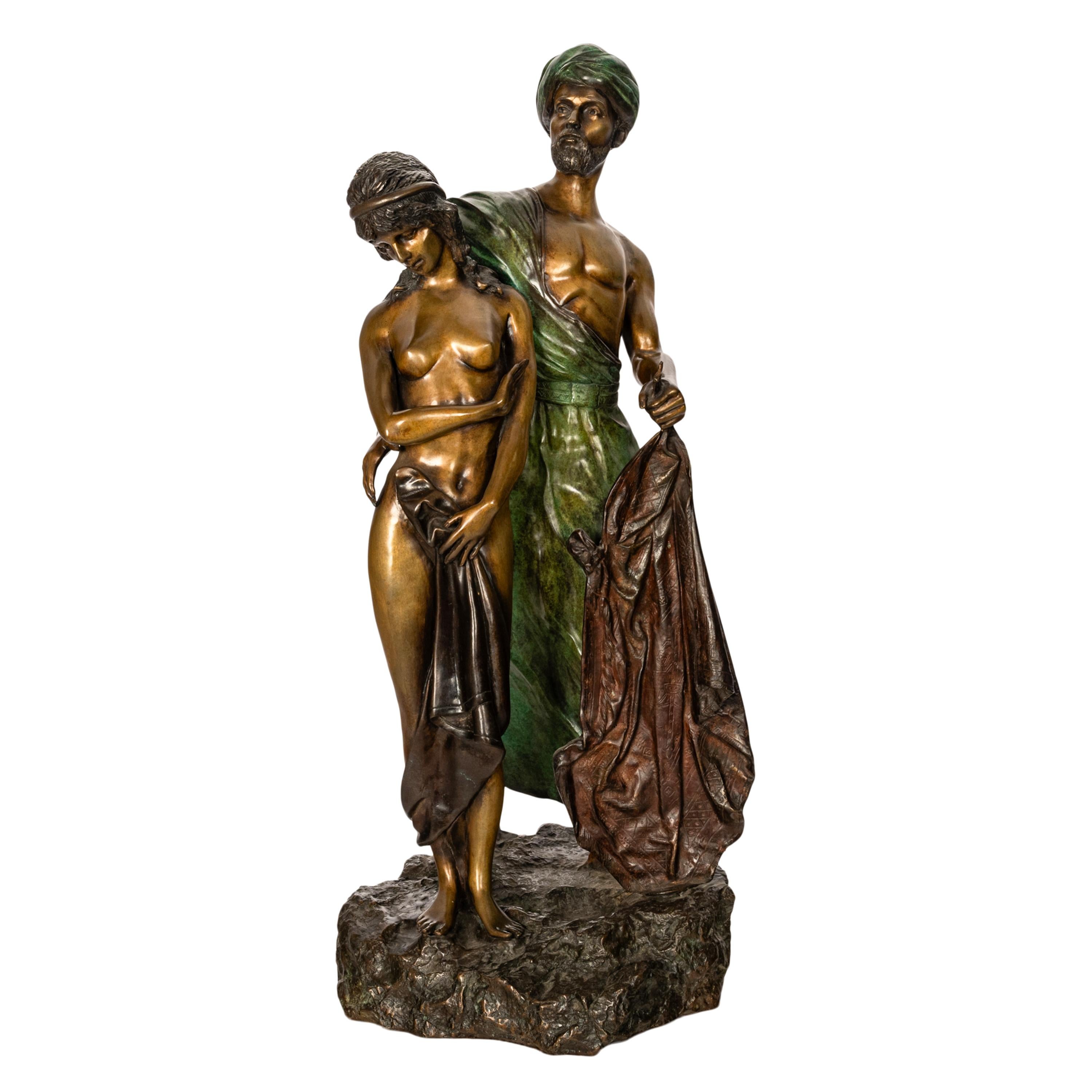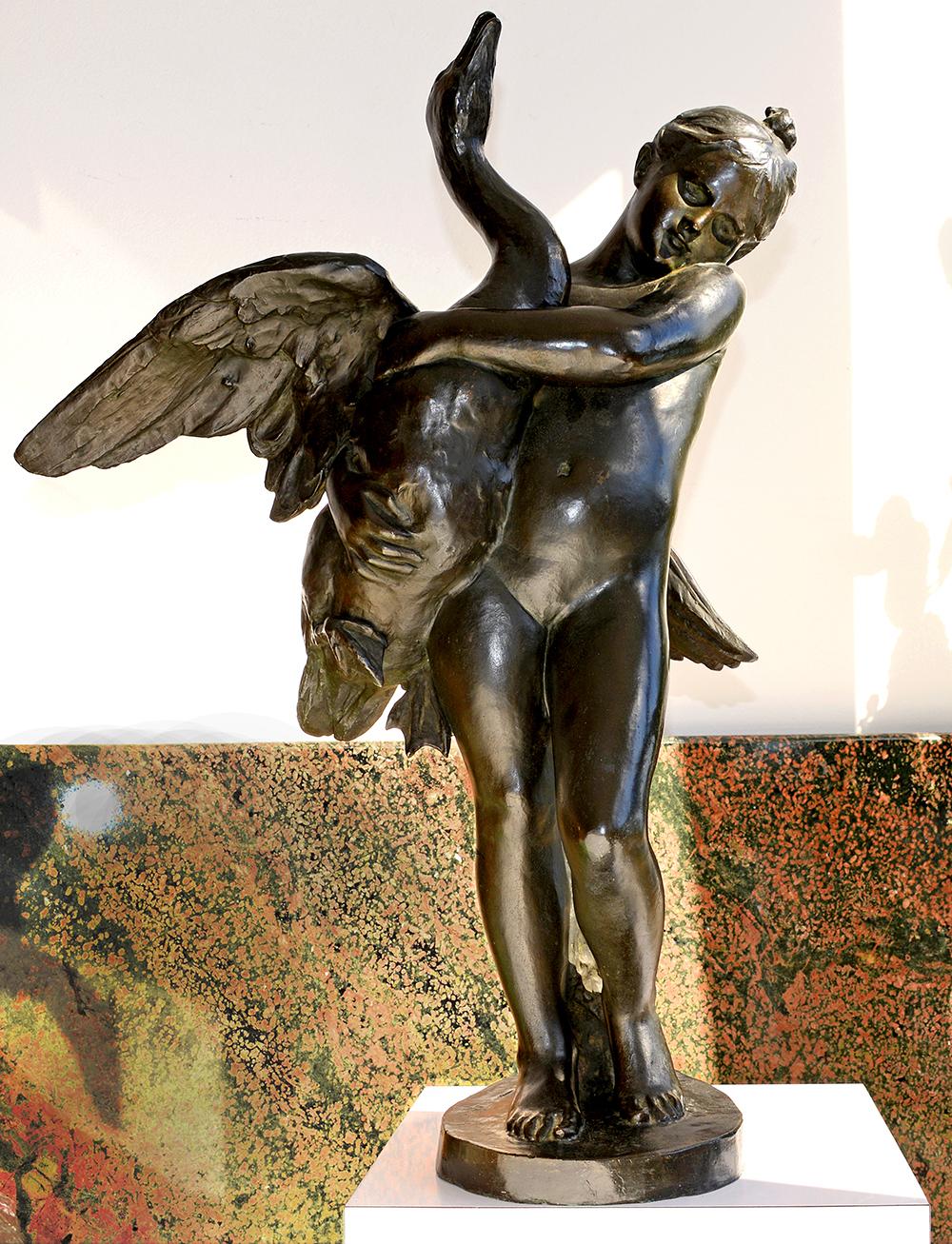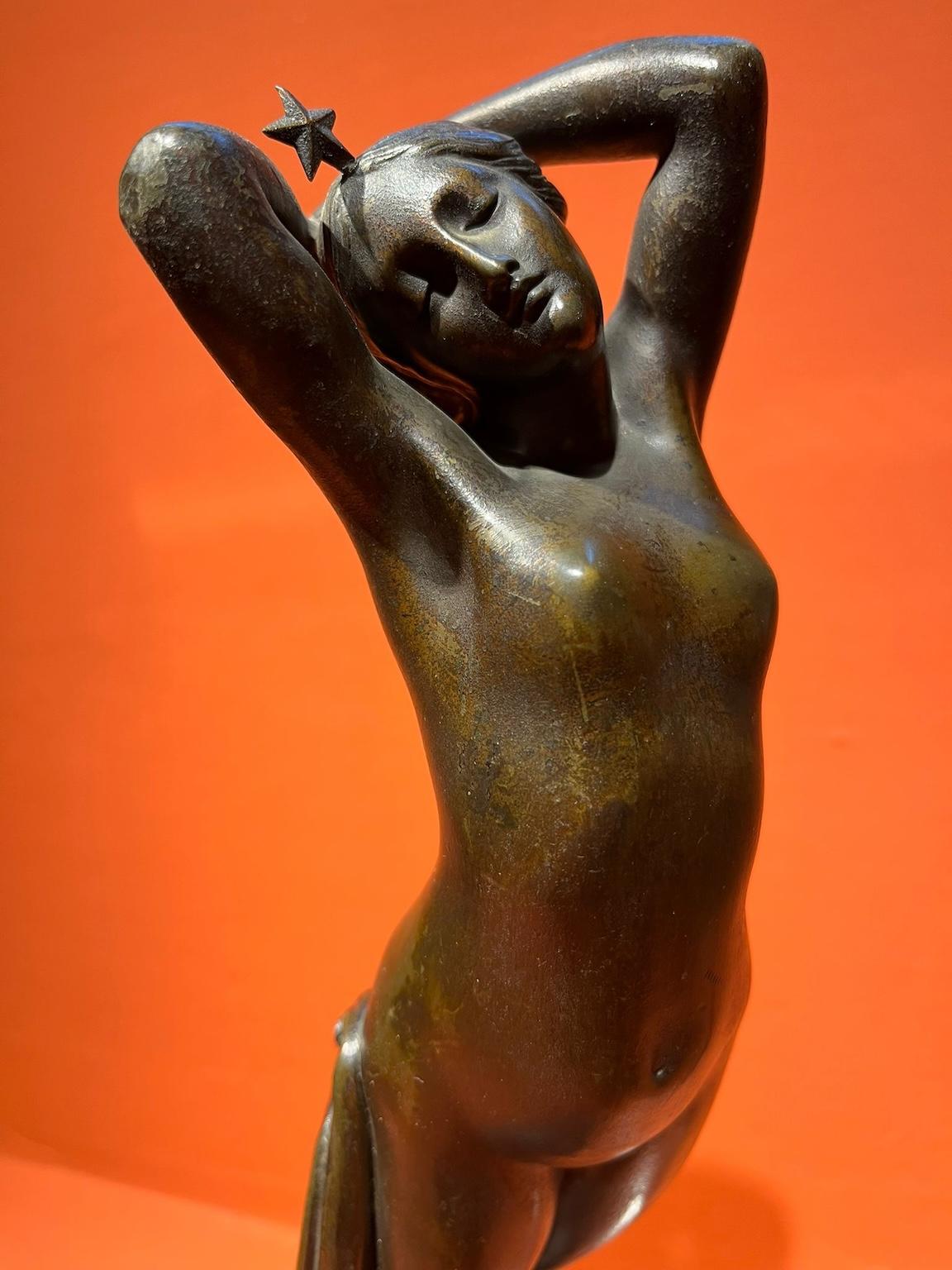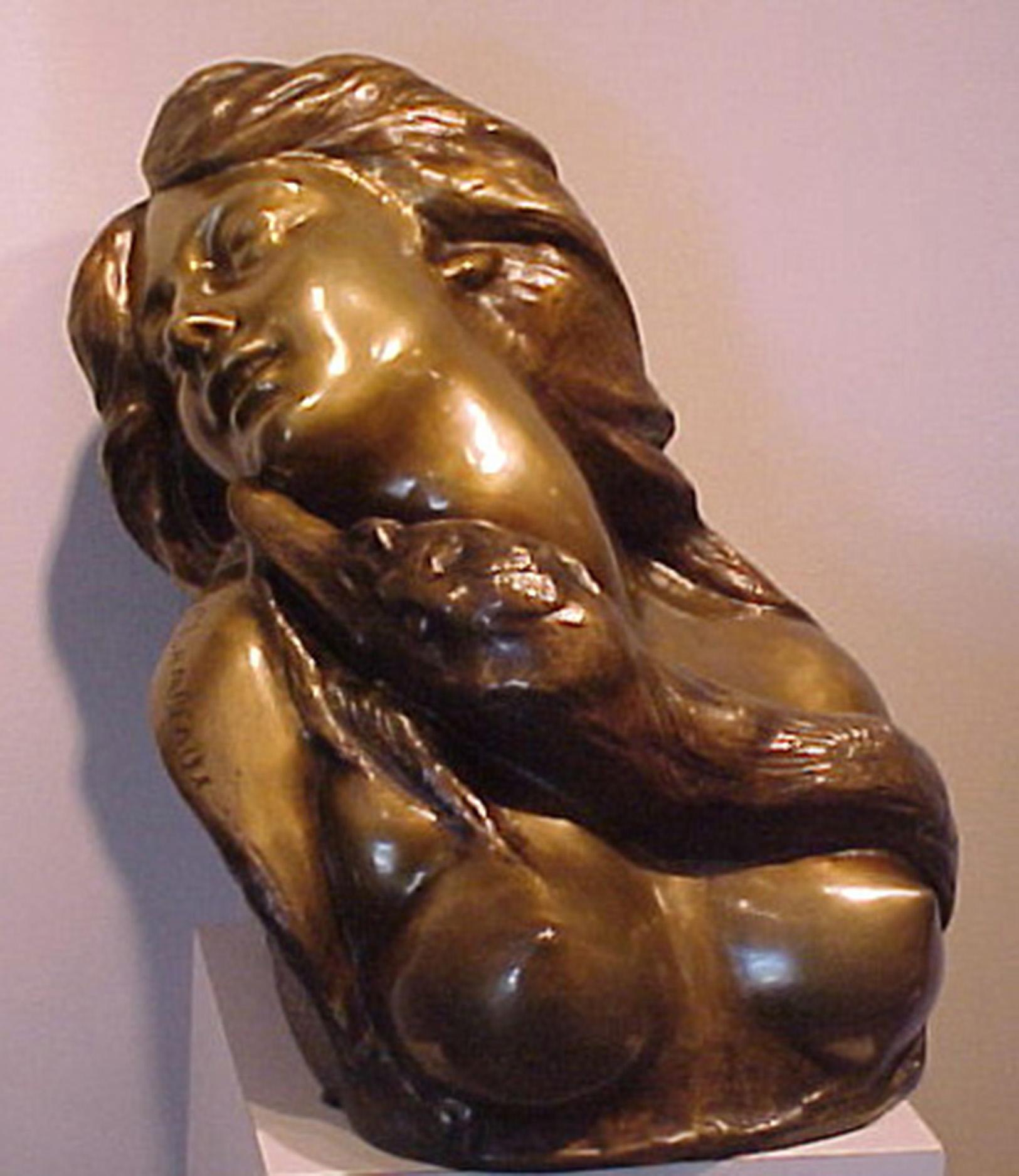Items Similar to The Song
Want more images or videos?
Request additional images or videos from the seller
1 of 18
Félix CharpentierThe Songcirca 1900
circa 1900
About the Item
"The Song" by Félix Charpentier (1858-1924)
A very fine bronze sculpture with nuanced dark brown patina
Signed "Fx. Charpentier"
Cast by "E. Colin & Cie Paris"
France
around 1900
height 68,5 cm
In 1890, Charpentier presented two major works at the Salon of French Artists, including "La Chanson" which won the Salon prize. The plaster purchased by the French State was placed in the vestibule of the Hôtel de Ville in Paris.
In 1899, the bronze reduction was presented in the salons of the Colin company, his editor since 1897.
Biography :
Maurice Félix Charpentier (1858-1924) said Félix Charpentier was a French sculptor. First a student of the School of Fine Arts in Avignon, Félix Charpentier was admitted to the workshops of Jules Cavelier and Amédée Doublemard at the School of Fine Arts in Paris in 1877. From 1879, he presented his works at the Salon of French Artists, where he exhibited each year.
Awarded a silver medal at the Universal Exhibition of 1889, his notoriety continued to grow. Charpentier exhibited that same year at the Salon the plaster of "La Chanson", then received in 1890, the first class medal and the Salon prize for his marble sculpted after this work.
In 1893, Charpentier was awarded the medal of honor for the "Wrestlers" marble, acquired by the French State and adorning the square of the town hall of Bollène, his hometown. From that date, the French State commissioned him for several public monuments, whether for the decoration of the Gare de Lyon in Paris, or the bas-relief "Contemporary Art" for the facade of the Grand Palais in Paris.
Appointed Knight of the Legion of Honor since 1892, following the inauguration of the Centenary Monument of the annexation of Avignon and Comtat Venaissin to France, Charpentier was promoted to Officer of the Legion of Honor in 1901.
In 1899, Austria awarded Félix Charpentier the gold medal at the Vienna International Triennial Exhibition for the "Sleeping Globe". We owe him many statues kept in several national museums, such as "L'Étoile filante" (Nîmes fine arts museum). Charpentier's works also adorn many public gardens. After the First World War, he received numerous orders for war memorials.
- Creator:Félix Charpentier (1858 - 1924, French)
- Creation Year:circa 1900
- Dimensions:Height: 26.97 in (68.5 cm)Width: 11.82 in (30 cm)Depth: 9.45 in (24 cm)
- Medium:
- Movement & Style:
- Period:
- Condition:
- Gallery Location:PARIS, FR
- Reference Number:

About the Seller
5.0
Vetted Seller
These experienced sellers undergo a comprehensive evaluation by our team of in-house experts.
Established in 1992
1stDibs seller since 2023
Typical response time: 17 hours
- ShippingRetrieving quote...Ships From: PARIS, France
- Return PolicyA return for this item may be initiated within 3 days of delivery.
More From This SellerView All
- Nature unveiling in front of ScienceBy Louis Ernest BarriasLocated in PARIS, FRNature unveiling in front of Science by Louis-Ernest Barrias (1841-1905) Bronze sculpture with multiple patina. Signed "E. Barrias" on the side of the base cast by "Susse Frères" (foundry mark and stamp) The model of this statue was commissioned in 1889 to decorate the new medical school in Bordeaux. When he had finished the first version in white marble for the school, Barrias designed a second marble and onyx statue in 1899 for the ceremonial staircase of the Conservatoire des Arts et Métiers in Paris. France circa 1900 height 58 cm Biography : Louis-Ernest Barrias (1841-1905) was a French sculptor . He came from a family of artists. His father was a porcelain painter and his older brother, Felix-Joseph Barrias, a recognized painter. Louis-Ernest Barrias entered the School of Fine Arts in Paris in 1858, he abandoned painting to move towards sculpture under the direction of François Jouffroy. In 1864, he won the Prix de Rome, on the theme of "The Foundation of Marseille", and was engaged on the site of the Paris Opera house. He later produced many sculpted works, most of them in marble. In 1881, Louis-Ernest Barrias was awarded a medal of honor of the fine arts and named knight of the Legion of Honor in 1878, then promoted officer in 1881 and commander in 1900. The artist replaced Auguste Dumont at the Institute in 1884, then succeeded Jules Cavelier as a professor at the School of Fine Arts, where, among his most notable students, there were Victor Ségoffin, Charles Despiau and Paul Landowski.Category
Early 20th Century Art Nouveau Figurative Sculptures
MaterialsBronze
- Apple DancerBy Jean-Léon GérômeLocated in PARIS, FRApple Dancer by Jean-Léon GEROME (1824-1904) Bronze sculpture with a dual patina, brown and gilded signed on the base "JL. GEROME" cast by "Siot-Decauville Fondeur Paris" (foundry s...Category
1890s Art Nouveau Figurative Sculptures
MaterialsBronze
- Diana with an arrowBy Albert-Ernest Carrier-BelleuseLocated in PARIS, FRDiana with an arrow by Albert-Ernest CARRIER-BELLEUSE (1824-1887) Bronze sculpture with a dual light and dark brown patina signed on the base "Carrier-Belleuse" inscribed on a front plaque "Diane à la Flèche par Carrier-Belleuse (Sculptr)" France circa 1870 height 83 cm arrow added probably in the 20th c. Biography : Albert-Ernest Carrier de Belleuse known as Carrier-Belleuse (1824-1887) was one of the most prolific artists of the century and had the greatest successes under the Second Empire, enjoying the personal support of Napoleon III. His work was greatly influenced by the style of the Italian Renaissance and that of the 18th century, which he helped to bring up to date. In 1837, the young Carrier-Belleuse apprenticed in the workshop of the engraver Bauchery. He was admitted soon after to the goldsmith Jacques Henri Fauconnier. Through François Arago, he met the sculptor David d'Angers who facilitated his admission to the School of Fine Arts. Carrier-Belleuse entered it in 1840. Noted for his skill by the great bronze companies in Paris such as Barbedienne and Denière, he soon received numerous orders for models for candelabras, pendulums, fittings for fireplaces, etc. In 1848, probably at the initiative of François Arago, who became head of state, he received his first public order for a small statue of "Mademoiselle Rachel singing La Marseillaise". In 1851, he appeared for the first time at the Salon of French Artists, where he presented two bronze medallions. From 1851 to 1855, Carrier-Belleuse stayed in England, in Stoke-on-Trent where he served as director of the modeling and drawing school of the Minton house, a large porcelain manufacturer. Back in France, Carrier-Belleuse moved to Paris in a large workshop located 15 rue de la Tour d´Auvergne. From 1857, he made regular sendings to the Salon and became famous thanks to the success of large marbles, such as the "Bacchante" exhibited at the Salon in 1863, and acquired by Napoleon III, "Angelica" (1866) or even "Hebe asleep" (1869). At the Salon of 1867, his group entitled "Messiah" earned him the medal of honor of sculpture. It was acquired by the State to adorn the Chapel of the Virgin in the Saint-Vincent-de-Paul church. Carrier-Belleuse acquired a great reputation in parallel for his terracotta busts which, in many respects, recall those of 18th century artists. He made portraits of a large number of celebrities of his time. He produced, among others, the busts of Napoleon III, Renan, Thiers, Grévy, Arago, Marguerite Bellanger, Théophile Gautier, Honoré Daumier, Delacroix, Hortense Schneider, Réjane… He also modelled numerous busts of mythological inspiration and historical and artistic portraits like Marie Stuart, Shakespeare or even Mozart. Carrier-Belleuse used and trained in his workshop in the rue de la Tour d´Auvergne many young talented artists such as Alexandre Falguière, Jules Desbois...Category
1870s French School Nude Sculptures
MaterialsBronze
- Snake CharmerBy Albert-Ernest Carrier-BelleuseLocated in PARIS, FRBronze sculpture with a nuanced dark brown patina signed on the base "A. Carrier" inscribed on a front plaque "Charmeuse de Serpents par Carrier-Belleuse" France circa 1860 height 80,5 cm Biography : Albert-Ernest Carrier de Belleuse known as Carrier-Belleuse (1824-1887) was one of the most prolific artists of the century and had the greatest successes under the Second Empire, enjoying the personal support of Napoleon III. His work was greatly influenced by the style of the Italian Renaissance and that of the 18th century, which he helped to bring up to date. In 1837, the young Carrier-Belleuse apprenticed in the workshop of the engraver Bauchery. He was admitted soon after to the goldsmith Jacques Henri Fauconnier. Through François Arago, he met the sculptor David d'Angers who facilitated his admission to the School of Fine Arts. Carrier-Belleuse entered it in 1840. Noted for his skill by the great bronze companies in Paris such as Barbedienne and Denière, he soon received numerous orders for models for candelabras, pendulums, fittings for fireplaces, etc. In 1848, probably at the initiative of François Arago, who became head of state, he received his first public order for a small statue of "Mademoiselle Rachel singing La Marseillaise". In 1851, he appeared for the first time at the Salon of French Artists, where he presented two bronze medallions. From 1851 to 1855, Carrier-Belleuse stayed in England, in Stoke-on-Trent where he served as director of the modeling and drawing school of the Minton house, a large porcelain manufacturer. Back in France, Carrier-Belleuse moved to Paris in a large workshop located 15 rue de la Tour d´Auvergne. From 1857, he made regular sendings to the Salon and became famous thanks to the success of large marbles, such as the "Bacchante" exhibited at the Salon in 1863, and acquired by Napoleon III, "Angelica" (1866) or even "Hebe asleep" (1869). At the Salon of 1867, his group entitled "Messiah" earned him the medal of honor of sculpture. It was acquired by the State to adorn the Chapel of the Virgin in the Saint-Vincent-de-Paul church. Carrier-Belleuse acquired a great reputation in parallel for his terracotta busts which, in many respects, recall those of 18th century artists. He made portraits of a large number of celebrities of his time. He produced, among others, the busts of Napoleon III, Renan, Thiers, Grévy, Arago, Marguerite Bellanger, Théophile Gautier, Honoré Daumier, Delacroix, Hortense Schneider, Réjane… He also modelled numerous busts of mythological inspiration and historical and artistic portraits like Marie Stuart, Shakespeare or even Mozart. Carrier-Belleuse used and trained in his workshop in the rue de la Tour d´Auvergne many young talented artists such as Alexandre Falguière, Jules Desbois...Category
1860s French School Figurative Sculptures
MaterialsBronze
- Woman taking off her shirtLocated in PARIS, FRWoman taking off her shirt by James PRADIER (1790-1852) Bronze with a nuanced brown patina cast by SOYER and INGE France circa 1850 height 28,5 cm Biography : Jean-Jacques Pradier...Category
1850s French School Nude Sculptures
MaterialsBronze
- ApolloBy Henri BouchardLocated in PARIS, FR"Apollo" by Henri Bouchard (1875-1960) An Art Deco period masterpiece! Exceptional bronze sculpture with a golden-brown patina Signed " H. Bouchard " Unique piece This work personifies Apollo, god of the Arts. Represented here as Apollo Musagète, leader of the procession of muses and winner of the serpent Python. This subject was commissioned to adorn the entrance to the Palais de Chaillot in Paris, and whose monumental bronze is still exhibited there. To participate in the Venice Biennale in 1938, Henri Bouchard had reduced in 1937 the large Apollo of the Palais de Chaillot, which had not yet been installed. Vintage cast by Bisceglia (cast founder stamp) made during the artist's lifetime. Incised dedication below signature : " à mon cher ami E. Sandoz " This is a unique cast made for the sculptor Edouard-Marcel Sandoz (1881-1971). This cast was exhibited at the 1938 Venice Biennale. France 1937 height : 82 cm width : 45 cm depth : 30 cm weight : 31,2 kgs Stickers under the bronze cast : - Sticker mentioning that this cast has been exhibited at the Venice Biennale of 1938 under the number 354 ("Biennale Internaz. d'Arte Venezia – 1938 – XVI – 354"). - Sticker mentioning that this cast went through Italian customs ("ne – merci – dogana italiana – visitate - 9622") - Damaged Sticker mentioning the name ("A…") and the address ("25…") of the owner of the cast (maybe for the workshop "Atelier Henri Bouchard", 25 rue d’Yvettes, 75016 Paris). Provenance : - Edouard-Marcel Sandoz, Paris, according to the dedication. - Property from the Collection of Seymour Stein (entrepreneur and founder of Sire Records, famous American record label ; and avid collector of 19th and 20th century fine art...Category
1930s Art Deco Figurative Sculptures
MaterialsBronze
You May Also Like
- Franz Bergmann Orientalist Arab Slave Nude Group Cold Painted Bronze Signed 1910By Franz BergmannLocated in Portland, ORA very large 24" (61cm) Franz Xavier Bergmann (1861-1936) cold painted bronze group statue, signed, Austria, circa 1910. The bronze in the Orientalist manner & depicts a young slave ...Category
1910s Art Nouveau Figurative Sculptures
MaterialsBronze
- Nude Girl and Swan BronzeLocated in Miami, FLThis stylized figural study captures a young girl restraining a struggling swan trying to take flight purportedly by Marius Jean Antonin Mercié, bearing the incised signature “Mercié” on the base.. The work is quite heavy weighing in about 65 lbs and boasts an opulent dark patina. Unlike his signature work Gloria Victis, that has numerous versions, reproductions and casts, Girl and Swan may be of just a few casts or may be unique. With Barbedienne foundry mark on the tree stump behind the left foot. Mercie used Barbedienne for many of his works. Purchased from Toulouse Antiques...Category
1910s Art Nouveau Nude Sculptures
MaterialsBronze
- 19th century French mythological figurative female bronze statuetteBy Joseph PolletLocated in Florence, ITLate 19th-century bronze figure derived from a work by Jean Michel-Angel Pollet-a Palermo artist of French parents who was a pupil of Bertel Thorvaldsen and Peter Tenerani - titled ...Category
Late 19th Century Art Nouveau Nude Sculptures
MaterialsBronze
- Leda and the SwanLocated in West Hollywood, CAPresenting a magnificent early Art Nouveau bronze by Belgian artist Jef Lambeaux(1852-1908.) “Leda and the Swan”, is an original Art Nouveau Bronze,...Category
1880s Art Nouveau Figurative Sculptures
MaterialsBronze
- Jean Garnier Bronze of a Sea Nymph or SirenBy Jean GarnierLocated in San Francisco, CAJean Garnier (1853-1910) Art Nouveau Bronze Sculpture circa 1890s A Fine bronze sculpture by listed French artist Jean Garnier. A young nude woman with long flowing hair and a tamb...Category
Late 19th Century Art Nouveau Nude Sculptures
MaterialsBronze
- Modernist Bronze Sculpture of a Nude WomanLocated in Soquel, CAAbstracted sculpture of a nude woman by Francis Xavier "Frank" Bracken (American, 20th Century). Signed, dated and numbered "Francis X. Bracken 1981 2/7...Category
1980s Art Nouveau Nude Sculptures
MaterialsSteel, Bronze
Recently Viewed
View AllMore Ways To Browse
Punu African Tribal Face
R Thiele
Ramie 610
Redware Figure
Riho Kuld
Ritual Wine Vessel Gong
Sacred Langur
Sebastian Burdon
Stephen Hansen Sculpture
Stephen Hansen
Tiffany Cat Bookends
Tomasz Koclega
Tower Of Babel Barnaby Barford
Uwe Schloen
Mariko Scuptures
The Most Famous Of Maya Lins Works Is
Martin Duque
Marc Sijan On Sale



